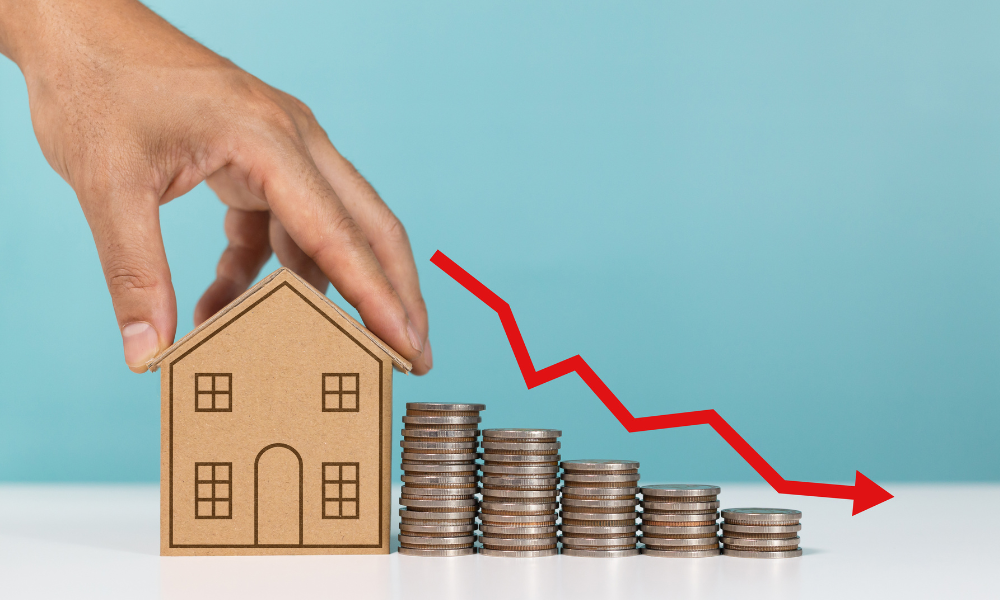Looking for affordable homes in the US? We’ve listed the top ten undervalued real estate markets in this article. Start your search here

As home prices continue to rise, many Americans are searching for affordable properties outside of the major centers. While places like Los Angeles and Washington, D.C. continue to be out of reach for many prospective homebuyers, there are other options. If you have clients who are willing to buy properties in areas that are not as popular as LA and DC, you are in luck.
One great alternative to major cities is undervalued real estate markets. These locations offer less expensive property prices than their actual value. For potential home buyers who are not focused on a specific area in terms of buying properties, this can be a viable option. Choosing to invest in undervalued properties is also beneficial for real estate investors and portfolio landlords.
In this article, Mortgage Professional America will discuss ten of the most undervalued real estate markets in the US. We will tackle what defines this market trend so you and your clients can understand it further. Is housing overvalued in nearly all parts of the US? Read on to find out.
What are the most undervalued housing markets?
Do you have clients who are not particular about living in metropolitan areas and are willing to make adjustments? You can introduce them to properties in undervalued real estate markets. This is especially true if they are looking for homes with affordable price tags.
Here are 10 of the most undervalued housing markets in the US:
1. Crown Heights, New York
- Average home value: $978,278
- Median list price: $796,333
- Difference: $181,945
If we’re talking about affordable house prices, New York is probably not the first place that comes into mind. Surprisingly, Crown Heights in Brooklyn is the most undervalued real estate market on our list. It boasts a median list price that is more than $150,000 less than its average home value.
Take a tour in this neighborhood by watching this clip:
2. Clewiston, Florida
- Average home value: $240,659
- Median list price: $96,167
- Difference: $144,492
The second spot is taken by Clewiston. It is a city in Hendry County, Florida which can be found on the south bank of Lake Okeechobee. Clewiston might be an underpriced real estate market, but it has many outdoor activities to offer for residents and tourists alike. Notable destinations are available in this area such as:
- Clewiston Museum
- Dixie Crystal Theatre
- Ah-Tah-Thi-Ki Seminole Indian Museum

3. Urban Honolulu, Hawaii
- Average home value: $868,820
- Median list price: $727,613
- Difference: $141,207
Urban Honolulu is another undervalued real estate market, ranking at third place. It is the most populated city in the state of Hawaii. It is also both the country’s westernmost and southernmost metropolitan area. Urban Honolulu is jampacked with tourist attractions like:
- Waikiki Beach
- Hanauma Bay
- Aloha Tower
- Diamond Head
- Honolulu Zoo
- Bishop Museum
- Honolulu Museum of Art
- National Memorial Cemetery of the Pacific
Check out this video on the top eight things to do in Honolulu:
4. San Jose, California
- Average home value: $1,413,477
- Median list price: $1,279,648
- Difference: $133,829
The fourth on our list of undervalued real estate markets is San Jose, California. This location might have expensive properties, but they are still undervalued. The famous Silicon Valley, which is regarded as a world hub for technological advancements and innovation, is where San Jose is situated as the largest city. There are also numerous landmarks here like:
- Dr. Martin Luther King, Jr. Library
- Cathedral Basilica of St. Joseph
- History Park at Kelley Park
- Plaza de César Chávez
- Rosicrucian Egyptian Museum
5. San Francisco, California
- Average home value: $1,260,086
- Median list price: $1,177,667
- Difference: $82,419
The official city and county of San Franciso has a number of homes with skyrocketing prices. However, it is still considered an undervalued real estate market. San Francisco has tons to offer especially in terms of tourist spots. It is where the world-renowned Golden Gate Bridge is located.

6. Okeechobee, Florida
- Average home value: $278,461
- Median list price: $221,833
- Difference: $56,628
While the average home value in Okeechobee is more than $250,000, the median list price is significantly lower. This is why Okeechobee ranks among the most underpriced real estate markets in the US. Here is a video if you wish to explore Okeechobee:
7. Cape Girardeau, Missouri
- Average home value: $205,589
- Median list price: $163,117
- Difference: $42,472
Currently, the average home value of Cape Girardeau exceeds its median list price. This city is famous for its restaurants and shopping centers. It might be a relatively small location, but it has much to offer aspiring residents.
8. Ben Lomond, California
- Average home value: $952,493
- Median list price: $929,000
- Difference: $23,493
If you have clients who like the summer heat, they might like it in Ben Lomond. This area’s housing market is underpriced since the median list price is lower than the average home value by more than $20,000.
Those who want outdoor activities like hiking and camping in the forests are also welcome in Ben Lomond. It has a nearby mountain, Ben Lomond Mountain, that shares a similar name to another mountain in Scotland.

9. Raintree, Texas
- Average home value: $240,880
- Median list price: $223,217
- Difference: $17,663
The median list price in Raintree is lower than the city’s average home value. As such, Raintree made it to our list of undervalued real estate markets at the ninth spot. For those who want affordable rental costs, there are numerous apartments in Raintree that offer low charges for renters.
10. Eau Claire, Wisconsin
- Average home value: $299,681
- Median list price: $294,950
- Difference: $4,731
Finally, we have Eau Claire. It is in the Eau Claire and Chippewa counties in Wisconsin. The city’s underpriced housing market is evident from the fact that the average home value is $4,731 higher than its median list price. Eau Claire is famous for having these lakes:
- Dells Pond Lake
- Half Moon Lake
Find out what this city’s outdoor activities and tourist spots are like when you watch this video:
Both the average home values and median list prices listed above are sourced from Zillow’s report.
What defines an undervalued real estate market?
An undervalued real estate market in the US is characterized by several key factors. These include:
- low demand
- affordable property prices
- increased rental demand
- investment potential
- market sentiment
- favorable affordability ratios
Let us discuss these factors to further understand what undervalued real estate markets are:
1. Low demand
A location where properties are low in demand can indicate an undervalued real estate market. In turn, you can grab the opportunity and share this tip with your clients who want to achieve their homeownership dream. There might also be some sellers who are desperate to have their properties purchased—be sure to keep an eye out for them.
2. Affordable property prices
When houses are valued way below their average costs in an area or neighboring markets, this can mean that the location’s real estate market is undervalued. Lower property prices often attract aspiring homeowners who are looking for affordability, especially first-time property buyers.
Less expensive price tags for homes are considered a key factor in determining whether a real estate market is undervalued or not. Do some research on the historical list prices for properties so that your clients can have potential returns on their property investments over time.
Want to know where property buyers can find affordability in the US housing market? Read this article to find out.
3. Increased rental demand
If you want to know whether a housing market is undervalued or not, check if the rental demand is increasing. A rental market with high occupancy rates can suggest that the area has undervalued properties, since renters will flock to places with low rental costs.
In markets where occupancy rates are high, rental properties can generate consistent income. This makes them attractive to property investors. Do you have clients who are real estate investors? If they want to be successful, share these top ten real estate investing strategies with them.
4. Investment potential
Investment potential is often found in undervalued housing markets with planned infrastructure improvements, such as newly constructed roads and others like:
- schools
- commercial districts
- public transportation
Once these developments are set, they can enhance property values and attract more residents. Over time, this will make the area more desirable. Property enthusiasts and investors who recognize these trends early can capitalize on future growth.
5. Market sentiment
Market sentiment can also influence the undervaluation of a real estate market. Negative perceptions due to economic downturns or past disasters might keep buyers away. This keeps property prices low.
These situations are often temporary. Real estate investors who look beyond the current market sentiment and focus on long-term goals might show interest despite the undervaluation of properties in a particular area.
6. Favorable affordability ratios
Affordability ratios are necessary for evaluating market health. Favorable ratios of home prices to income levels suggest that properties are accessible and potentially undervalued compared to nearby locations. When home prices are low relative to local income levels, it means that properties are accessible to a larger demographic.
This accessibility can drive demand for renters, property buyers, and real estate investors. As such, it can eventually lead to price appreciation as more people enter the undervalued property market.
Why choosing undervalued real estate markets is good for home buyers
Aspiring home buyers who want to buy property in undervalued real estate markets can enjoy the perks of securing property in an area that has a lot of potential. Real estate investors can also benefit from the low property prices that undervalued housing markets have. Price appreciation is likely in locations that are undervalued especially when both rental and buyer demand increases.
If you have clients who want less expensive properties in promising areas, you can suggest undervalued real estate markets to help them climb the homeownership ladder in no time.
Would you advise your clients to buy their homes or invest in undervalued real estate markets? Why or why not? Let us know in the comments below.



